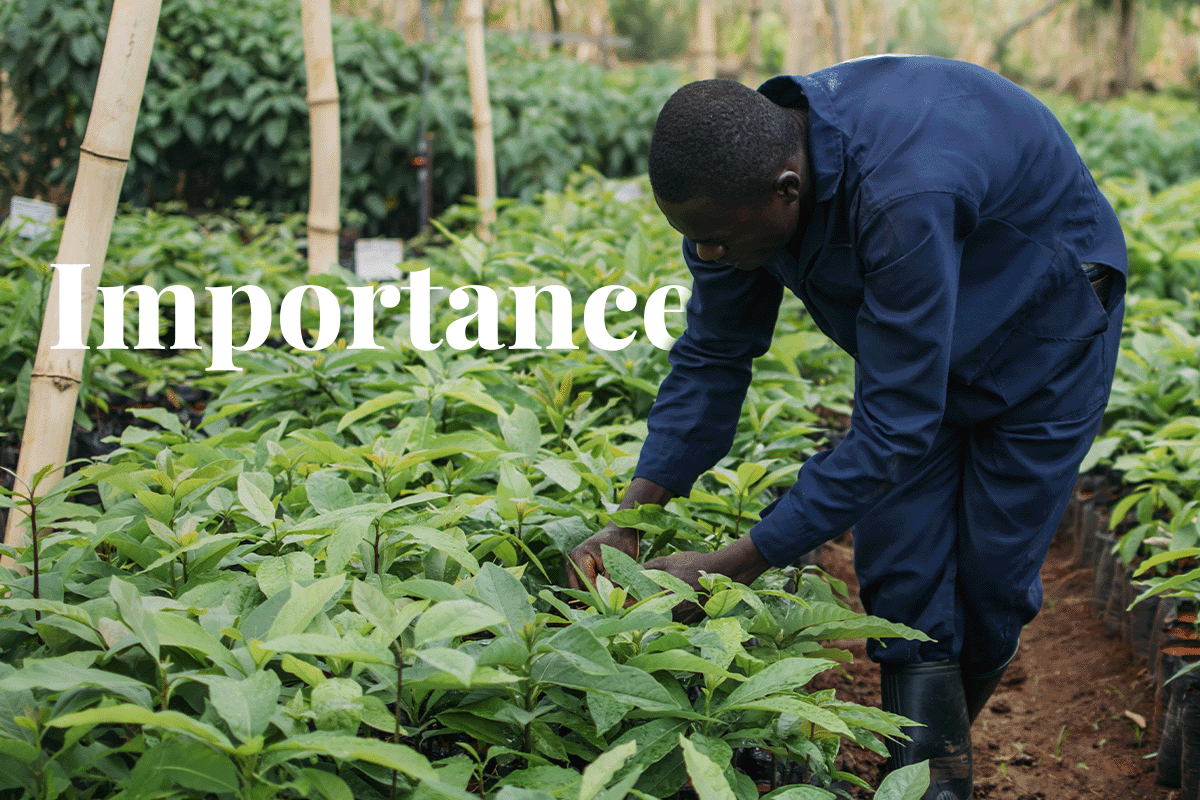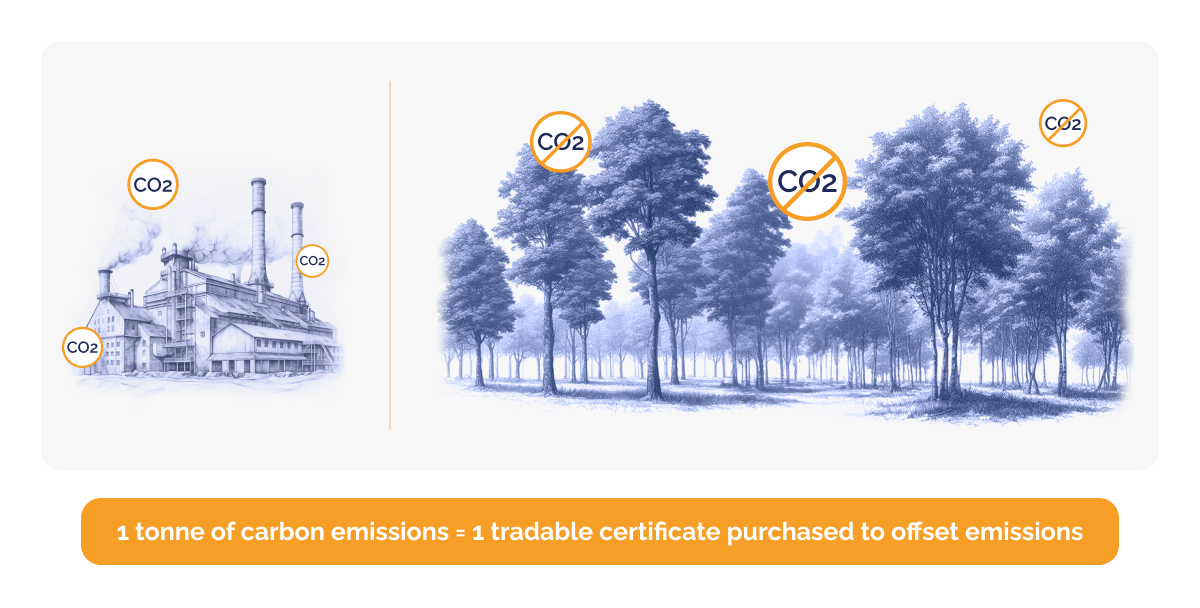In recent years, the escalating concerns surrounding environmental sustainability have prompted a global shift towards achieving net-zero emissions. This transformation represents a pivotal moment in the collective effort to protect nature. At the forefront of this movement is the concept of carbon offsetting (or carbon compensation), an increasingly vital strategy gaining traction for its pivotal role in mitigating the impact of carbon emissions. This blog will explore the profound significance of carbon offsetting in the context of achieving net-zero emissions, unravelling its mechanics, delving into its myriad benefits, and explaining the pivotal role it plays in environmental, economic, and social domains.
 A local working in a tree nursery in Kenya, Hongera Reforestation Project, DGB.
A local working in a tree nursery in Kenya, Hongera Reforestation Project, DGB.
Understanding carbon offsetting and net-zero emissions
Carbon offsetting serves as a linchpin in comprehensive net-zero strategies, offering a practical and indispensable approach to counterbalancing the unavoidable emissions produced by businesses and industries. In essence, it acts as a mechanism to mitigate the environmental impact of carbon emissions by investing in projects that contribute to reducing or removing an equivalent amount of carbon emissions from the atmosphere.
This proactive measure aligns with the broader goal of achieving carbon neutrality or net zero, a state where the hard-to-abate carbon emissions generated are compensated for by the removal or reduction of an equivalent amount. The offsetting process involves supporting initiatives that either prevent the release of carbon emissions or actively remove them from the air, thus creating a balance between emissions produced and those mitigated.
Read more: How nature-based projects contribute to net-zero goals
Carbon offsetting is not a mere transaction; it represents a conscientious effort by organisations to take responsibility for their carbon footprint. By engaging in this process, companies acknowledge the environmental impact of their operations and actively contribute to global efforts to conserve nature.
The relationship between carbon offsetting and net-zero emissions is intricate and symbiotic. Carbon offsetting acts as a bridge, allowing businesses to navigate the path towards net zero by compensating for emissions that cannot be entirely eliminated. It serves as an integral part of a holistic and sustainable business approach, emphasising the importance of not only reducing emissions but also actively participating in initiatives that contribute positively to the environment.
The mechanism behind carbon offsetting
Carbon credits (also known as carbon units), the fundamental currency of carbon offsetting, represent a measurable reduction or removal of carbon emissions. Each carbon credit, which is a tradable certificate purchased to offset emissions, represents 1 tonne of carbon emissions mitigated. Carbon credits are generated by carbon projects and are traded in the voluntary carbon market on various platforms. Organisations wishing to offset and reduce their carbon footprint purchase these carbon credits to achieve their net-zero goals.
Read more: How are carbon credits issued?
Not all carbon offset projects however are created equal. While they all focus on carbon mitigation, nature-based solutions (NBS), like those of DGB Group, are considered a premium choice due to their additional environmental and socio-economic advantages, such as biodiversity preservation, community support, and sustainability. NBS emphasises environmental benefits and showcases the potential for long-term ecological balance.
 Carbon offsetting illustration.
Carbon offsetting illustration.
Benefits of carbon offsetting
Environmental benefits
Carbon offsetting is not a singular act confined to emission reduction; it encompasses a holistic approach that reverberates across environmental spheres. By actively contributing to the preservation of biodiversity and enhancing air and water quality, carbon offsetting emerges as a powerful tool for nature conservation. In this subsection, we will delve into the multifaceted environmental benefits of adopting carbon compensation practices, with a specific emphasis on the benefits of NBS and their pivotal role in maintaining ecological equilibrium.
- Preserving biodiversity: At the heart of carbon offsetting’s environmental impact is its significant contribution to biodiversity preservation. Traditional carbon reduction measures often focus solely on mitigating emissions, potentially neglecting the intricate web of ecosystems. Carbon offset projects, especially those rooted in NBS, actively prioritise the restoration and protection of natural habitats. This commitment not only aids in capturing carbon but also safeguards the rich tapestry of plant and animal life, fostering biodiversity hotspots that are critical for the overall health of the planet.
 Two Bulindi chimpanzees sitting in a tree, Bulindi Chimpanzee Habitat Restoration Project, DGB.
Two Bulindi chimpanzees sitting in a tree, Bulindi Chimpanzee Habitat Restoration Project, DGB.
- Enhancing air and water quality: Beyond its role in biodiversity conservation, carbon offsetting plays a crucial role in improving air and water quality. Many NBS carbon offset projects involve activities such as afforestation and reforestation, which entail the planting of trees. Trees act as natural filters, absorbing pollutants from the air and promoting cleaner, fresher air. Additionally, these projects often involve sustainable land management practices that contribute to improved water quality by preventing soil erosion and promoting healthy watersheds.
- The benefits of nature-based solutions (NBS): NBS emerge as a beacon of environmental stewardship within the realm of carbon offsetting. Unlike some conventional offsetting methods that may rely on technological interventions, NBS harnesses the power of nature itself. Whether through afforestation, reforestation, or sustainable land management, NBS projects not only sequester carbon but also deliver a myriad of co-benefits. The emphasis on natural processes makes NBS a sustainable, resilient, and ecologically sound approach to offsetting carbon emissions.
 Aerial view of a tree nursery, Hongera Reforestation Project, DGB.
Aerial view of a tree nursery, Hongera Reforestation Project, DGB.
- Maintaining ecological equilibrium: The ecological equilibrium of our planet is delicately balanced, and human activities often disrupt this balance. Carbon offsetting, particularly through NBS, seeks to restore and maintain this equilibrium. By promoting sustainable ecosystems and community empowerment, these initiatives contribute to environmental resilience, supporting the adaptation of flora and fauna to changing environmental conditions. NBS projects actively work towards ecological harmony, creating a positive feedback loop that benefits both the environment and societies.
 A local woman with a new cookstove, Hongera Energy Efficient Cookstoves Project, DGB.
A local woman with a new cookstove, Hongera Energy Efficient Cookstoves Project, DGB.
Carbon offsetting, when approached comprehensively and with a focus on NBS, transcends its primary goal of emission reduction. It becomes a catalyst for preserving biodiversity, enhancing air and water quality, and maintaining the delicate equilibrium of our planet's ecosystems. Through a deeper understanding of these multifaceted environmental benefits, businesses and individuals can make informed choices that not only mitigate their carbon footprint but also contribute meaningfully to the overall health and sustainability of our shared environment.
Economic and social impacts
- Job creation and sustainable development: Carbon offset projects, especially those rooted in NBS, possess the potential to create employment opportunities and foster sustainable development. Investing in carbon offsetting can thus positively impact local economies and communities, positioning it as a catalyst for socio-economic growth.
 A local working in a cookstove factory, Hongera Energy Efficient Cookstoves Project, DGB.
A local working in a cookstove factory, Hongera Energy Efficient Cookstoves Project, DGB.
- Economic opportunities in the carbon offset market: Beyond environmental stewardship, compelling economic incentives exist for businesses to engage in carbon compensation. The economic opportunities presented by the carbon offset market, such as a competitive edge and improved compliance, offer a comprehensive path for businesses seeking to align with sustainable practices and reap the benefits of a burgeoning green economy.
- Social responsibility and corporate citizenship: Carbon offsetting aligns seamlessly with the principles of social responsibility and corporate citizenship. The global call from consumers for eco-friendly businesses underscores the importance of businesses embracing carbon neutrality as part of their commitment to society and the planet, benefitting from the broader impact on brand reputation and corporate identity.
Read more: Net zero: benefits, challenges, strategies, and the power of nature-based solutions
Integrating carbon offsetting into business strategies
Corporate adoption of carbon-neutral goals
In response to the escalating imperative of embracing carbon-neutral goals, a growing number of businesses are undertaking proactive measures to align their operations with sustainability principles.
Businesses are increasingly recognising that achieving net zero is not merely a commendable environmental initiative but a strategic necessity. The transition towards net zero is driven by a multifaceted approach that extends beyond internal operational changes. Instead, it involves a comprehensive strategy that encompasses not only emissions reduction but also active participation in initiatives that contribute positively to the environment.
How can you offset your emissions?
Seamless integration of carbon offsetting into broader sustainability strategies begins with a thorough assessment of your company's carbon footprint. This involves identifying and quantifying the sources of emissions across the entire value chain. With this baseline established, businesses can then strategically implement measures to reduce emissions internally, adopting energy-efficient technologies, optimising supply chains, and implementing sustainable practices.
Carbon offsetting plays a pivotal role as an integral component of this broader strategy. It allows businesses to address emissions that cannot be eliminated through internal measures by investing in carbon projects. These projects, often NBS, not only offset emissions but also align with broader sustainability goals, including biodiversity preservation, community development, and ecosystem restoration.
 A gazelle in its natural African habitat.
A gazelle in its natural African habitat.
Integrating carbon offsetting into your business strategy also assists with Corporate Social Responsibility (CSR) and Environment, Social, and Governance (ESG) reporting, appealing to investors, attracting more funding, and aligning your company with increasing environmental regulations such as the new Corporate Sustainability Reporting Directive (CSRD).
Read more: The power of sustainability: Why investing in sustainability drives faster company growth
The role of governments and regulatory frameworks
Governments play a pivotal and dynamic role in sculpting the landscape for carbon offsetting, acting as architects of regulatory frameworks that support and incentivise businesses to actively engage in carbon offset initiatives.
Governments worldwide are increasingly recognising the urgency of addressing nature conservation, and as such, they are wielding their regulatory authority to create an environment conducive to sustainable practices. Regulatory frameworks are designed to set clear guidelines for businesses, outlining the parameters within which carbon offsetting can be effectively implemented and ensuring fair and transparent participation across industries.
Crucially, regulatory frameworks are not static; they evolve in response to the changing dynamics of environmental challenges. As environmental science advances and our understanding of carbon offsetting deepens, governments refine and adapt their policies. This adaptive approach ensures that regulations remain effective and relevant, encouraging continuous improvement in carbon offset practices and aligning with broader nature-centred goals.
Incentivising businesses to engage in carbon offsetting is a key aspect of governmental strategy. This may take the form of financial incentives, tax credits, or preferential treatment for businesses that actively participate in offset initiatives. By providing tangible benefits, governments encourage compliance and stimulate a culture of innovation, pushing businesses to explore new and more effective ways of reducing their carbon footprint.
Governments, through their regulatory frameworks, create an environment where sustainability is a strategic imperative. This transition is marked by a shift towards cleaner technologies, sustainable practices, and an overarching commitment to reducing carbon emissions.
Encouraging consumer participation
Fostering widespread success in carbon offsetting hinges on actively engaging consumers in this critical journey. Engaging consumers in the carbon offsetting journey demands a multifaceted approach. Companies can leverage user-friendly platforms, integrating carbon offset options seamlessly into consumer experiences. Whether through e-commerce checkouts or dedicated apps, making carbon compensation accessible and user-friendly enhances participation. Businesses can also integrate tree planting into their consumer offerings with DGB’s trees for businesses product. This allows businesses to plant trees on behalf of clients and offer tree planting at check-out as an easy way to offer clients an opportunity to participate in nature restoration.
Integrate trees into your business
Education emerges as a powerful catalyst for consumer involvement. This involves demystifying the intricacies of carbon offsetting, clarifying its impact, and conveying the tangible benefits of individual contributions. Through informative campaigns and transparent communication, consumers gain a deeper understanding of their role in nature conservation.
Measure your environmental impact
Awareness campaigns play a pivotal role in inspiring consumer action. Leveraging social media, influencers, and traditional marketing channels can create a groundswell of support. The success of carbon offsetting is contingent on fostering a collective sense of responsibility among consumers. By framing individual actions as integral components of a larger, global effort, companies can instil a sense of shared accountability. This shared responsibility becomes a driving force, encouraging consumers to view carbon offsetting as a personal commitment to a healthier planet.
DGB Group’s nature-based solutions
In the realm of successful global carbon initiatives, DGB stands as a reference point for environmental stewardship and impactful nature-based solutions. As a publicly traded purpose company, DGB is uniquely positioned as a project developer focusing on high-quality, large-scale carbon and biodiversity projects that are accredited by leading verification standards, embodying the essence of nature-based solutions.
 Close-up of a local planting a tree seedling in a tree nursery, Hongera Reforestation Project, DGB.
Close-up of a local planting a tree seedling in a tree nursery, Hongera Reforestation Project, DGB.
DGB’s commitment to nature restoration is reflected in its nature-based projects strategically designed to address both social and environmental challenges. These impactful projects go beyond traditional approaches, harnessing the inherent power of nature to create lasting change. The emphasis on biodiversity protection and ecosystem services positions DGB as a pioneer in utilising nature-based solutions for sustainable development.
At the core of DGB's initiatives lies the recognition that carbon compensation is a vital tool not just for addressing carbon footprints but also for the restoration of nature. The demand for carbon credits is burgeoning globally, driven by organisations striving to achieve net zero. DGB's approach to carbon offsetting goes beyond compliance, embodying a genuine commitment to restoring ecosystems and empowering local communities.
DGB extends its impact through biodiversity credits, offering businesses and communities a significant opportunity to invest in nature. This approach acknowledges the interconnectedness of biodiversity and the environment, reinforcing the idea that thriving ecosystems are pivotal for a healthy planet and fostering resilience.
Explore DGB’s nature-based projects
Carbon offsetting with DGB Group–the path to net zero
The importance of carbon offsetting cannot be overstated in the pursuit of net zero. This exploration has outlined the intricacies of carbon offsetting, emphasising its environmental, economic, and social benefits. As we stand at the crossroads of environmental sustainability and environmental crises, the call to action is clear: businesses and individuals must embrace carbon offsetting as a tangible and effective strategy for achieving a sustainable future.
DGB's global projects are grounded in tangible outcomes. With over 31.2 million trees being planted, 250,000 hectares of land being restored, and 60+ million tonnes of CO₂ to be captured, DGB's projects are shaping a sustainable future. Importantly, these initiatives contribute to job creation and community wellbeing, with over 600 jobs set to be generated and 300,000 efficient cookstoves to be distributed, showcasing a commitment to both environmental and social sustainability.
Exploring DGB's successful nature-based carbon initiatives provides invaluable insights into the practical application of carbon compensation. Through DGB's projects, we gain a deeper understanding of effective environmental stewardship and witness the transformative impact of a well-executed carbon strategy. DGB's dedication to nature-based solutions, coupled with our tangible achievements and verified carbon units, helps organisations to balance their environmental impact while contributing to the restoration and preservation of our planet. With DGB, you can compensate for your organisation’s emissions and reach your net-zero goals.
Offset your carbon emissions and take positive steps for nature








